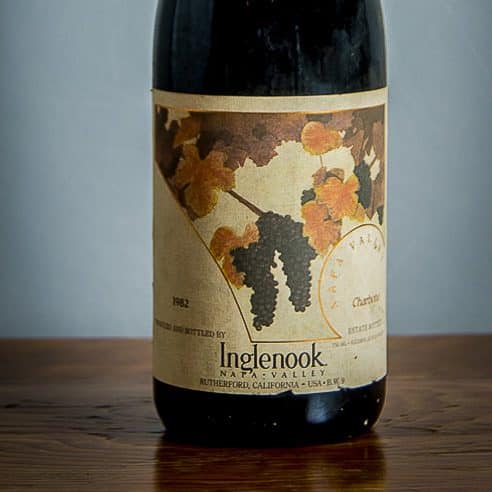Among the odd bottles I have written about, the 1982 Inglenook Charbono was not quite as odd as I had thought it was when I pulled it out of my crawlspace/wine cellar to test for a possible article.
This is not to say that I figured there were many other people around the world that Monday night in November (2014) drinking this specific wine. But it is to say that I thought it might be among the last of its kind.
Recent research has disabused me of that sort of wine drinker’s (sometimes insufferable) arrogance. It turns out that Charbono (to quote Jeff Cox in the best article I have read about the wine, “the grape variety that’s unknown to millions, ignored by most of the rest of us and adored by just a lucky few”) is making something of a comeback in reputation, if not in general popularity. According to wine bloggers Monty and Sara Preiser, some fifteen American wineries are now making it and its price ranges from about $20 to $45 a bottle.
I had paid some $6 tops when I bought this bottle in the 1980s. And I had kept it all this time (alongside a 1983 of same) because…well, I had no idea what it would taste like and when I should serve it (time-wise and food-wise). So when I pulled this supposed peculiarity from the cellar, little did I know that it would be one of the best bottles of wine (American, at least) I have ever drunk.
It was opened, that November Monday night, to accompany ziti in a tomato and sausage ragu.
Intense fragrance rose from the large Syrah glass I had poured it into. The wine tasted of black currants and black raspberries (I don’t usually assign other fruits to wine — as one of my kids always used to say, “It smells like grapes,” not that a wine often does, exactly).
At thirty-two years old it was scarlet at its core and only slightly bricked at the edge. I judged it had at least twenty years to go (so I will grab hold of that ’83 for dear life, and by dear life I mean a life made more precious by the promise of more good wine).

If only other California wines — cabs, zins, syrahs, petite sirahs (okay, maybe not petite sirahs) — were made like this today. Perhaps the key is in the alcohol content: a classic (by Bordeaux standards) 12.5 percent.
I liked the wine so much that I called a friend to come right over to taste it (and have some pasta). He couldn’t make it that night, so I recorked the wine and had it with food for the next five nights, until there was just a bit left and I brought it to that friend’s house and said, “Try it now,” and we did. He agreed that it was full of fruit and as full of joy as anything inanimate can be (at such an age, multiplied by how many days it had now been open to air).
Inglenook pioneered this wine and made it, as Jeff Cox reports, every year from 1882 until 1998. To me it tasted Italian, but its origin is French (corbeau/charbonneau).
Sally Ottoson, who runs Pacific Star, one of the most beautiful and interesting wineries in the United States (and a bottle of whose 1992 Charbono I rediscovered only this week in the crawlspace), is known as The Queen of Charbono and says that the wine’s flavor is difficult to describe, “So I like to say, it’s like an old woman who puts perfume in the same spot every day and it kind of sinks into her skin and you get this essence that evokes memories.”
I read that description months after I’d jotted down my own first impression of the wine:
Not the most profound wine but one of the most interesting (especially considering its provenance) and, surely, satisfying (by itself and in view, again, of its provenance). It’s a great Italian [oops!] in a gritty, smoky, earthy way, and American in its fruity exuberance and its (in a good way) simplicity, accessibility, fruit-forward cheeriness. What’s most surprising is its age-worthiness, like a simple, happy child who grows into a fascinating old man who has lived a fine, fruitful life. How lucky for everyone fortunate enough to be at his dinner table. ![]()
First published June 2015
